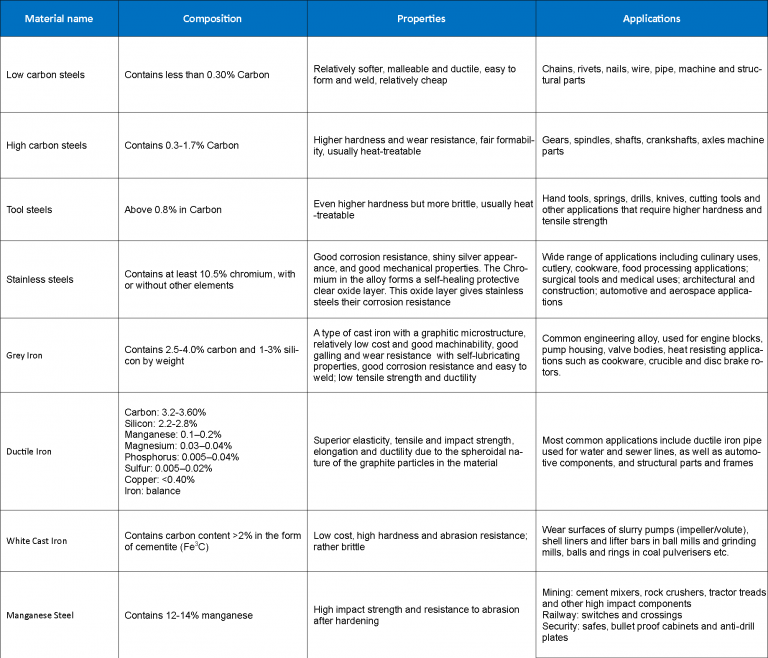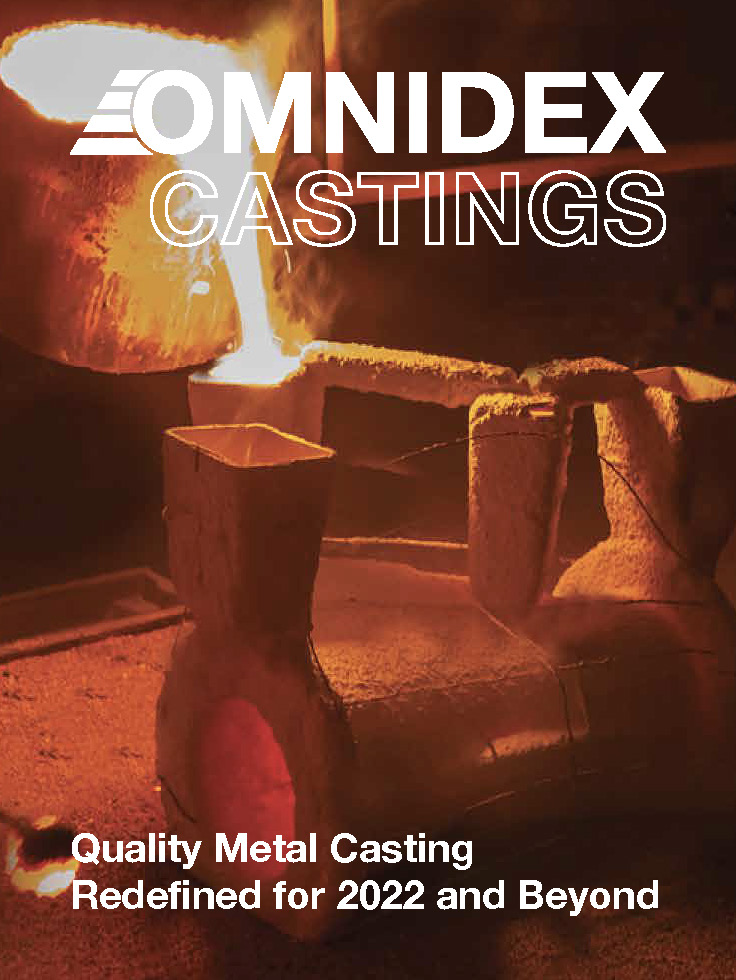We are always ready to help with your latest Casting project.
Contact our Customer Service and let us know how we can help to catapult your next project to success.
Ferrous metals may be defined as those metals whose main constituent is iron such as pig iron, wrought iron, cast iron, steel metal, etc. The principal raw material is pig iron and they are usually stronger and harder than being used in daily life products.
Ferrous material possesses a special property that its characteristics can be altered by heat treatment processes or by the addition of a small quantity of alloying elements. They possess different physical properties according to their carbon content.
Metal with the descriptor “ferrous” means that it has iron in its composition. When the term is used, it also usually implies that iron is a large percentage of the elemental composition. If it’s not the most abundant element, it would probably be the second or third most prolific.
If a metal only contains trace amounts of iron, as many others do, then that small amount is not considered enough to declare the metal ferrous.
Due to its particular properties, it has a wide range of uses. It is used extensively in the construction sector for example, where super-tough engineering steel is used to build with.
Cast iron is used a lot in things like water pipes where its hard-wearing properties are valuable. Wrought iron is used for fencing and railings where its resistance to oxidisation is vital. The engineering sector also makes extensive use of these metals for building machines and tools.
It is difficult to assign common properties since they can have a wide variety of alloying elements that greatly change their characteristics. For instance, many of them are magnetic; however, it is not true for all ferrous metals.
Austenitic stainless steel, while considered a ferrous metal, is not magnetic because a large amount of nickel allows it to have a crystal structure that is predominantly austenite at room temperature.
Austenite is not magnetic, although it does contain iron. Some of them, such as cast iron, are extremely strong and brittle. However, low carbon steel, another type of ferrous metal, can be quite soft and ductile because it does not contain as high of an amount of carbon as cast iron.
While it is difficult to place the properties of all ferrous materials under one umbrella, there are some generalizations that can be made with some accuracy.
Ferrous metals often have relatively high amounts of strength, especially when compared with copper, tin, and lead alloys. They are also generally hard, and if they’re not alloyed with many other elements or coated, can be subject to rust. Most ferrous materials, with the exception of austenitic stainless steel and some other grades, are magnetic.
There are many different types of ferrous metals. The following are some examples :
Pig Iron is the first or basic form in which Iron is prepared as the metal from its ores. It is, therefore, impure and crude and requires subsequent processing to develop Cast, Wrought Iron, and Steel, which are the common types used in construction and industries.
It is also called foundry pig. It is soft in character and rich in carbon. It is produced when the raw material is burnt at a very high temperature.
It is also called forge Pig Iron, as it is hard and brittle and can be converted only by using pressure. This type contains sulfur as the main impurity and hence is considered inferior in grade.
It is specially used in the manufacture of Steel in the Bessemer process, because of its freedom from sulfur and phosphorous.
Cast Iron is derived from Pig Iron. Pig Iron, because of its impurities, is weak and hence very difficult to shape into various forms. Therefore, Pig Iron is remolded in a furnace and cast or poured into molds of the desired shape to get the Iron known as Cast Iron.
Steels can be classified in many ways such as on the basis of the methods used in their manufacture, on the carbon content, or according to their use. It can also be classified on the basis of Steel. It is, however, the classification on the basis of their chemical composition is commonly adopted. Following are the major groups of Steel.
Grey Cast Iron is produced by melting the foundry Pig Iron or grey Pig Iron in the cupola furnace. It shows grey colour when fractured. The grey colour is due to the presence of free graphite.
The usual composition of Grey Cast Iron is:
It is soft and ductile. It is commonly used in castings, dies, molds, machine frames, and pipes, etc.
It is white in colour as there is no free graphite. In white Cast Iron, the entire carbon is in a combined state. i.e., in the form of cementite, also known as Iron carbide. White Cast Iron is produced by melting the low phosphorus Pig Iron along with the Steel scraps in a cupola furnace. The Cast Iron thus obtained is in a molten state, and it is chilled, i.e., it is cooled rapidly.
Therefore, it is also known as chilled Cast Iron. Due to rapid cooling, its outer surface becomes harder while its interior remains softer. It has a shiny white colour and a bright metallic white lustre. It is very strong, hard, and resistant to wear. And quite brittle as well.
Its usual composition is as follows:
Alloy Cast Irons are also called plain Cast Irons. Alloyed Cast Irons are produced by adding the alloying elements to the Pig Iron in the cupola furnace itself or adding the same into the molten Cast Iron taken out of the furnace. Better results are obtained when Pig Iron with alloying elements are heated in an electric furnace or air furnace. The alloying elements used are; nickel, chromium, molybdenum, and vanadium.
The usual alloying elements are Nickel and Chromium. Nickel is added to affect an increase in the hardness and resistance to wear. Chromium makes the Cast Iron extremely tough, strong and ductile.
While the alloy Cast Irons are used for gears, sprockets, wheels, I.C engine cylinders, piston, piston rings, crankcases, crankshafts, camshaft, brake drums and shoes, parts of grinding machines, etc.
It is the purest form of Iron, containing all impurities below a limit of 0.5 per cent. And carbon is included in these impurities, its proportion being generally less than 0.12 per cent. Besides, Wrought Iron always contains a small proportion of slag in the silicate component. The source material for the manufacture of Wrought Iron is PIG IRON.
Steel is an alloy of Iron and carbon, where the carbon content is less than 1.7%. If the carbon content in Steel exceeds 1.7%, it does not combine with the Iron, but it is present as free graphite. Besides carbon, many other metals may also be present in addition to Iron, giving rise to great varieties of Steel.
On the basis of the presence of free graphite, differentiation of Steel and Cast Iron can be made. If there is a free graphite present, it is a Cast Iron, otherwise a Steel. The hardness and toughness of Steel increase with the increase in carbon content up to 1.7%. On the other hand, with the decrease in the carbon content (lower than 0.1%), the material would resemble more Wrought Iron or pure Iron.
The best thing about Steel is that it has both properties of Cast and Wrought Iron – Compressive Strength of Cast Iron and Tensile Strength of Wrought Iron. Due to these properties, Steel is used as a structural material in all types of situations. Steel is a versatile material of the modern age. Its properties can be varied over a wide range by varying its composition and by subjecting it to various mechanical and heat treatment processes.
As we noted earlier, Cast Iron is better in resisting compressive stresses, while Wrought Iron is suited to tensile stresses. Steel is superior in resisting both compressive and tensile stresses. Hence, Steel finds most of the applications for all purposes in places of Cast Iron and Wrought Iron.
The elements of the composition of Steel apart from carbon are sulfur, silicon, phosphorus, manganese, etc.
This is the first major group of Steels. Carbon is the only controlling component in them besides Iron.
They are further subdivided into 3 subcategories.
An alloy is the purposeful mixture of two or more elements of which one being in largest proportion is called base metal, and other elements are called alloying elements. However, Steel, containing Iron and carbon, is not referred to as an alloy. But if elements are added other than Iron and carbon, the Steel is known as alloy Steel.
Thus all the Steels, in addition to Iron and carbon-containing other elements such as; nickel, chromium, manganese, silicon, vanadium, molybdenum, tungsten, sulfur, phosphorus, etc., are called alloy Steels.
The purpose of alloying is to improve the properties of Steel, like imparting the fine grain size, to improve the hardness, toughness, strength, corrosion resistance, etc. These are Steels made with the addition of a definite proportion of a selected element or elements in addition to carbon at the manufacturing stage.
Our company uses ferrous metals in different manufacturing processes (such as laser cutting, plasma cutting, CNC machining, welding etc.) and metal casting processes (such as sand casting, die casting, permanent gravity die casting, shell mold casting, lost foam casting, and investment casting).
For the last two decades, we have been providing quality metal casting services and metal fabrication services to our customers all over the world.

Contact our Customer Service and let us know how we can help to catapult your next project to success.

If you are looking for metal casting services, our brochure is a great way to discover what Omnidex has to offer. You can download HERE or EXPLORE HERE to learn more.

Copyright © 2022 Omnidex Group. All rights reserved.

If you are looking for metal casting services, our brochure is a great way to discover what Omnidex has to offer. You can download HERE or EXPLORE HERE to learn more.

Copyright © 2023 Omnidex Group. All rights reserved.
This website uses cookies so that we can provide you with the best user experience possible. Cookie information is stored in your browser and performs functions such as recognising you when you return to our website and helping our team to understand which sections of the website you find most interesting and useful.
Strictly Necessary Cookie should be enabled at all times so that we can save your preferences for cookie settings.
If you disable this cookie, we will not be able to save your preferences. This means that every time you visit this website you will need to enable or disable cookies again.